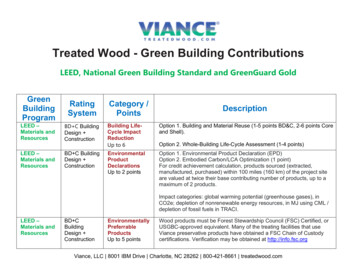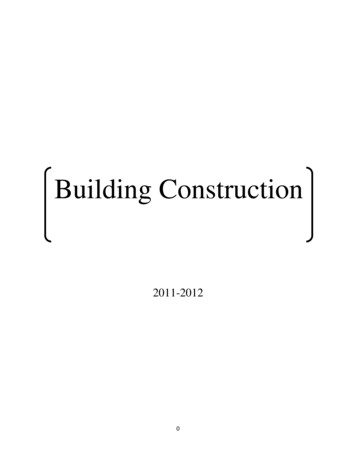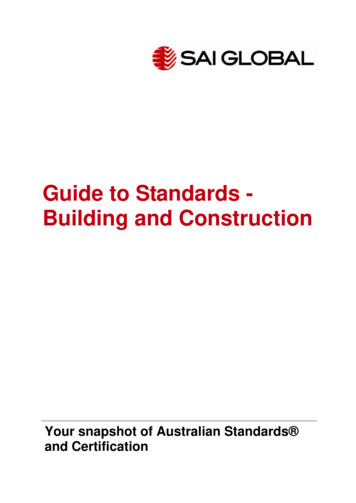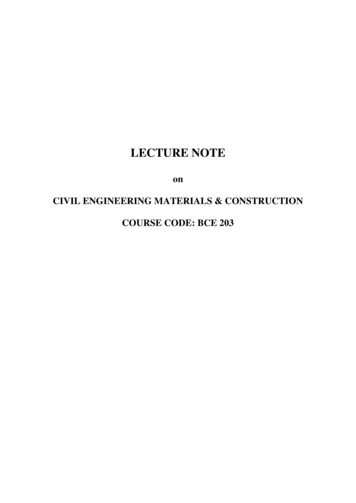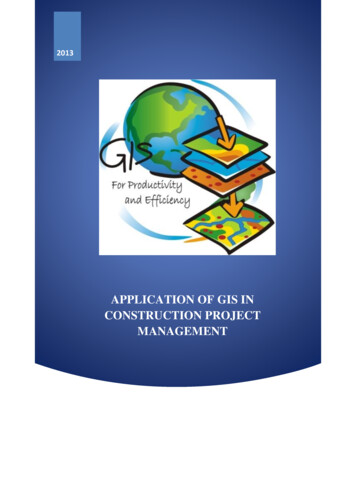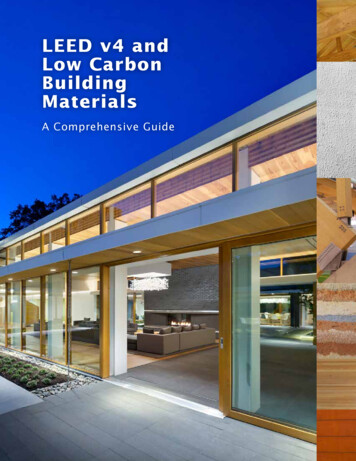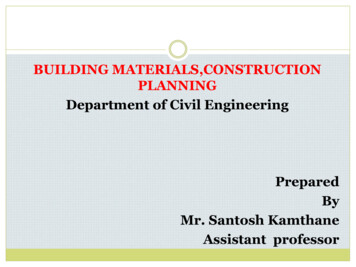
Transcription
BUILDING MATERIALS,CONSTRUCTIONPLANNINGDepartment of Civil EngineeringPreparedByMr. Santosh KamthaneAssistant professor
UNIT 1INTRODUCTION NATURALLY AVAILABLE MATERIALS INDISTRIAL MATERIALS STONE BRICK LIME CEMENT METEL CERAMICS
INTRODUCTION TIMBER SAND AGGREGATES MORTAR
Naturally Available Materials Clay / Earth / Soil Wood / Timber Sand / Fine Aggregate Rock
Artificial Or Industrial Materials CementBricksSteelTilesCeramicPaints and VarnishesGlassPlasticStoneLime
StoneRequirements of Stone Structure Appearance-Colour Texture Weight Fineness of Grains Durability Strength Hardness Facility of Working and Dressing
Types of Stone Igneous Rocks, Sedimentary Rocks,Metamorphic Rocks. Stratified, Unstratified, Foliated. Siliceous, Argillaceous, Calcarious.
Uses of Stone They are used in hydraulic structures like damsand bridges. They are used in retaining wall masonry to retainsoil. They are used as road metal in road construction. They are used as ballast for permanent way inrailways. They are used to make concrete in the form ofcoarse aggregate.
Properties of Stone Silicious rocks are hard and durable. They are not easily affected by weathering actions.Argillaceous rocks may be dense and compact or theymay be soft.The Durability of calareous rocks will depend upon theconstituents present in surrounding atmosphere.Marble and quartzite have compact crystalline structure.Igneous rocks contain many minerals. Various mineralshaving wide range of different distinctive characteristics.
Brick Requirements of BricksThe colour of the brick should be red or copper anduniform.It should be well burnt in kilns.The surface should be even and free from cracks.The edges should be sharp.
Types of Bricks Conventional / Traditional bricks :Size 23 cm x 11.4 cm x 7.6 cm Standard / Modular : Size : 19 cm x9 cm x 9 cm
Uses of brick Bricks are used in wall masonryconstruction of building Used in brick lintal construction Bats of brick are used in concrete infoundation work
Properties of bricks They are durable. They are low cost material. They possess good strength. They are easily available. Brick are light in compared to stones.
LimeRequirement of lime it should set easily. it should have low shrinkage. it should not contain impurities. It should be moisture resistant It should slake easily with water.
Types of lime Fat lime. Hydraulic lime 1)feebly 2)moderately 3)eminently Poor lime
uses of lime Lime is uses in the treatment of water and wastewater. It is used in the manufacture ofglass,refractory,sand lime bricks and paints. It is used as lime morter for mansonry work ofbuildings. It is used for plastering and white washing ofbuildings. It is used as lime concreat to make water proofstuctures.
Properties of lime It has good workability. It stiftens quickly. It has low shrikage. It has good resistant to moisture. Lime possesses good plasticity.
Cement Requirements of cement Cement should Cement should not possessof alumina which may reduce strength. not contain alumina in excess as it weakensthe cement. A very small amount of sulphur is added incement to make sound cement. It should found cool when touch by hand. it should be in fine powder form whilechecking with first finger and thumb.
Types of cement Ordinary portland cement(opc) Rapid hardening portland cement Quick setting cement Pozzuolana portland cement Low heat cement Blast furnace cement White cement Sulphate resisting cement Coloured cement
Uses of cement It is used in making joints for drains ,pipes. It is used to prepare RCC structures of building byusing reinforcement with cement concrete. it is used in construction of buildings, bridges,tanks, domes, flyovers, dockyard etc. It is used to prepare cement mortar for buildingconstruction works like masonry, plaster, painting,flooring etc. It is used to prepare cement concrete for variousconstruction works.
Properties of cement Physical properties of cement Mechanical properties of cement Chemical composition Fineness Soundness Setting of cement
MetalRequirements of metal They should provide sufficient strength to bear theloads coming on them They should provide resistance to corrosion andweather actions They should provided resistance to heat and fire. They should have good adhesion with cementconcrete.
Types of metal Ferrous metals1) pig iron2) cast iron3)wrought iron4)steel Non ferrous metals1) Aluminium2) copper3) Magnesium4) Nickel
Ceramics Requirement of ceramicsThey should provide resistance to stainsThey should be easy to cleanThey should be non- slippary while wetThe colours of ceramic products should be longlastingThey should be durable
Types of ceramics Crystalline Non crystalline Glass bonded Bricks Terra cotta Tiles Pipes ChimneyUses
Properties of ceramic It has low ductility. It has low resistance to impact low toughness. It has excellent dielectric properties. It has good resistance to corrosion. It has good chemical resistance.
Timber Requirements of timberIt should be dense.It should have uniform texture.It should have dark uniform colour.It should be workable, good machinability.The medullary rays should be compact.
Types Natural timberbabul, oak, pine, mango, sal, teak, neem, palms,chir. Industrial timberveneers, plywoods, fiberboards, impreg timber,compreg timber.
Uses Railway sleepers, bridges, pipes. Furniture, decorative pieces, doors. Packing material, piles, cart wheels. Poles, pen, rafter. Roofs, partition walls, boats etc.
Properties of timber It has low heat conductivity. It has small bulk density. It is relatively high strength. It is susceptible to decay. It is susceptible to flame.
Sand Requirements of sandIt should be clean.It should be well graded.Maximum permissible clay content is 3 to 4% insand.It should contain sharp, angular grains.It should not contain salts which attract moisturefrom the atmosphere.
Types of sand Naturalnatural sand is obtained from pits, river beds andsea beds. Artificialartificial sand is formed by decomposition ofsandstone due to various weathering effects.
Uses Sand is useful in various construction activities likemasonry work, plaster work, flooring and concretework. Sand is used in cement mortar, plan cementconcrete , reinforced cement concrete andprestressed concrete as key ingradient in buildingconstruction
Properties of sand It is naturally available material It is durable It mix with binding material easily It has shiny luster It is of whitish brown colour.
Aggregates Requirements of AggregatesAggregates should be sufficiently strong.Aggregate surface should be rough and free formcracks.Aggregate should have good soundness.Aggregate should have good adhering with bindingmaterial.
Types Fine aggregatessize of aggregate is 4.75 mm or less is termed asfine aggregates. Coarse aggregatessize of aggregates 80mm to 4.75 mm is known ascourse.
Uses Fine aggregates are used to prepare cement mortar,lime mortar and cement concrete. Course aggregates are used to prepare cementconcrete bituminous pavement, rigid pavement etc. They are used in construction of beams, columns,slab, lintel etc.
Properties of aggregates They are insoluble in water. They are of moderate weight. They are strong and durable. They have resistance to scratches. They have resistance to corrosion anddecay.
Mortar requirements of mortarIt should have good adhesion with bricks, stones.It should resist penetration of rain water.It should be cheap, durable, and workable.It should be set quickly.The joints formed by mortar should not developcrecks.
Types As per type of binding material.like cement, lime, gauged, gypsum, surkhi. As per nature of application. As per density of the mortar. Spicial morter.
Uses To bind the bricks or stones firmly in wall construction work.They are used in plaster work as finishing material toprovide weather resistance joints of masonry workare covered by plaster work. White wash and colourare applied on plastered surface easily.Properties of mortarMobility.Place ability.Water retention
CONCRETE Concrete is a mixture of cement/lime, sand, crushedrock,water. Preparation of concrete 1 Ingredient of concrete 2 Methods of mixing of concrete*TYPES OF CONCRETE 1 Plain cement concrete 2 Reinforced cement conceret 3 Precast concrete 4 prestressed concerte
PROPERTIES OF CONCRETE Workability Strength Durability Dimensional stabilityUSES Foundation to slabe in building Coating materil for water proofing
PAINT & VARNISHES The paints are coating of fluid materils and they areapplied over the surface of timber and metal. The varnishes are transprent or nearly solution ofresineous materials & they re applies over thepainted surfaces.
TYPES OF PAINTS Aluminium paints Cement paint Asbestos paint Bituminous paint Emulsion paint Oil paint Plastic paint Synthetic ruber
PROPERTIES OF PAINT & VARNISH They are available in wide range of variety. They are speaded & strached as a layer on base bybrushes. They are transparent They provide shine on old & new wood work.
REQUIREMENT OF PAUNT & VARNISHES The paints applied on a surface should dry within 24 hours.The paint should neither crack nor shrink afterdrying.The paint should have an attractive appearance.The colour of varnish should not develop cracks ondrying.The varnish should adopt or accommodate to theexpansion & contration of wood due to temperaturevarations.
GLASS Glass is anamorphuos,inorganic,homogeneous,transparent ortranslucent material.TYPES OF GLASS Soda lime glass Potash lime glass Potash lead glass
PROPERTIES OF GLASS It can not deform. It is hard. It has resistance to scratches. It is brittle. It is affected by alkalies. It is transparent or translucent. It is no effect of air & water.
PLASTIC The plastic is an organic substance and it consists ofnatural or synthetic binders or resins with or eithoutmoulding components.TYPES OF PLASTIC 1 THERMO PLASTIC 2 THERMOSETTING PLASTIC
PROPERTIES OF PLASTIC It is light in weight. Specific gravity of plastic is 1.40. They are low electrical conductivity. They are low thermal conductivity They can absorb shocks.USES To make waterproof doors,bags. To make furniture . To make optical lenses, frameas.
UNIT 2Cement and Admixtures
What Are They? Ingredients other than: Cement Water Aggregates Added before or during mixing.
Why Are They Used? To modify properties of fresh & hardened concrete To ensure the quality of concrete during mixing,transporting, placing & curing To overcome certain unexpected emergencies duringconcrete operations (ie, set retarders)
How Applied? Most admixtures are supplied in a ready-to-use formand added at plant or jobsite. Pigments and pumping aids are batched by hand inVERY small amounts
Effectiveness Factors effecting results of use: Type & amount of cement: Water content & Slump Chemistry effects due to portland componentsFlowability will effect how well admixtures are activated due tointernal agitation actitivityMixing time Effects of admixtures are dependent on time allowed to react.
5 Typical Functions of Admixtures: Air entraining Water-reducing Retarders Set Accelerators Plasticizers (superplasticizers) Some other “specialty” types exist: Color, corrosion inhibitors, etc.
Air Entrainment Developed in 1930s Today, recommended for all concretes exposed tofreeze/thaw cycles Imposes microscopic air cells that relieve internalpressure of freezing water Typical target air values are 5%-8% Will also increase slump (workability)
Master Builders Micro Air Performance: Improved air void system Improved workability & plasticity Reduced permeability Dosage 1/8 to 1-1/2 oz per cwt of cement Trial batch required to target air.
Water Reducers Internal lubricant Allows for reduction of water/cement ratio whilemaintaining workability (increased strength) Can reduce water requirement at least 5-10% Obtain higher slump without adding water Mid-range water reducers result in at least 8% Mid-range water reducers provide more consistentsetting times than standard water reducers.
Water Reducer: Pozzolith Performance: Improves workability at low w/c ratio Normal to retarded set times Helps eliminate “cold joints” Dosage: 4-10 oz per cwt of cement
Set Retarders Slows curing rate Used to counteract hot weather conditions that causeincreased rate of hardening. This makes placing and finishing difficult Pozzolith 961 Performance & dosage (see handout)
Set Accelerators Increase curing rate for achievement of high earlystrength Speeds up start of finishing operations Used for speeding curing rate in cold weatherconcreting Pozzolith 122 Performance & Dosage (see handout)
Master Builders Pozzolith Performance: High early strength Accelerated setting time characteristics Dosage: 16-64 fl oz/cwt (100 wt) cement Higher dosages increase acceleration rate
Superplasticizers Also known as high-range water reducers (HRWR) Reduce water requirement by 12-30% Can make low slump concrete flow like high-slump mix Makes mix highly fluid and can be placed with little or no vibration orcompaction Effect lasts only 30-60 minutes and is followed by rapid loss ofworkability Usually added at jobsite
UNIT 3PLUMBING SERVICES ANDBUILDING COMPONENTS
INTRODUCTION Building / Plumbing services include: Waterdistribution system Sanitaryfittings and Effectivedrainage system
Sufficient quantity of water is provided to thebuilding for the needs such as drinking, bathing,washing of cloths and washing of floors. Morequantity of water is used through sanitary fittingslike water closets, washbasins, sinks, bath roomsetc.
In addition, telephone services and electric fittingsare also come under the preview of building services.
WATER DISTRIBUTION SYSTEM /WATER SUPPLY: Water supply to water closets, bath rooms, wash basins,kitchens etc of a building is provided through watersupply pipes from municipal water mains which run alongthe streets.
Requirement of water for residences should be assumed as135 liters per head per day whereas the requirement variesfrom 45 to 70 litres per day for schools / restaurants / officesper seat. For water supply to the buildings / offices, always galvanizediron pipe of 15 mm dia is used.
SANITARY LINES & FITTINGS For collection of water, various types of to befitted in the building. All these fittings should be as far as possible befitted against an external wall.
Following are some of the examples for sanitaryfittings: washbasins sinks bathtubs watercloset
WASH BASINS: These are used for face washing etc andusually fixed that top of the basin is 78.5 cm. SINKS: These are used cleaning of utensils in kitchens orglassware items in laboratories. Sinks are rectangularbasins made from glazed earthen ware or stone-ware withflat bottom and all their internal angles are made round foreasy cleaning. Sinks are fixed in such a way that height ofthe top of the sink from floor is 90 cm.
BATH TUBS: These are made from enameled iron, plastic,Cast Iron, porcelain, marble. Normal dimensions of bath tubsare as follows: Length 1.7 Width .70 Overall- 1.85 mts– 75 cmsheight .58 – 60 cm
DRAINAGE SYSTEM:Drainage of a locality can bedivided into public drainage and private drainagesystems. Underpublicdrainagecategory,municipalsewers/drains are laid along the roads and are properlymaintained by municipal / corporation authorities.
Houses and buildings are constructed along boththe sides of the roads by laying own sewer linesinside the house / building premises under thecategory of private drainage system. These sewer lines collect sewage / waste waterfrom bathrooms, kitchens, water closets etc fitted inthe building and convey it to the municipal sewers.
The system of sewer lines or drains laid in thepremises of a building is called the house drainage.
Principles of house drainage House sewers / drainsshould be laid as far aspossible by the side of a building rather than belowthe building. The size ofdrain should be adequatemaximum discharge from the house.for
Drains should be laid at proper gradient so that the lowestlevel of the building may drain in it. Drain should be laid on good foundation and protectedagainst external loads. As far as possible, drains should be laid in straight lines withsuccessive inspection chambers.
The house drain should be connected to the publicsewer line which is always lower than the level ofhouse sewer else, the flow in reverse directionmay take place.
VENTILATIONS The process of supplying fresh air and removingcontaminated air by natural / mechanical process is termed asVentilation. To provide excellent conditions to live and Work Airmovement, temperature, Humidity conditions etc areimportant. The simultaneous control of temperature,humidity, air motion and air purity is known as airconditioning.
SYSTEMS OF VENTILLATION A good ventilating system should fulfill the followingrequirements: Itshould admit required amount of fresh air in the room. All the corners of the room should get proper ventilation. Desired humidity should be maintained. Effective temperature should be maintained. The ventilating air should be free from impurities such asdust, odour etc
The systems of ventilation may be divided into twocategories: NATURALVENTILATION MECHANICALVENTILATION
UNIT 4MASONRY AND FORM WORK87
Major Topics88 History Mortar Grout Brick TypesBondJoints Structural Clay Tile Concrete Block (CMU)
Topics con’t89 Masonry Panels Gypsum Block Glass Block Stone Stone Masonry
History90 One of the oldest manufactured building materials Sun-baked brick was found in the remains of structures inthe Tigres-Euphrates basin as early as 6000 B.C. Romans also used thin bricks in thick mortar made ofvolcanic materials and lime. 1633 – 1st brick buildings erected in Manhattan Island(imported from Holland & England)
Masonry Defined91An assembly or combination of small building unitsmade of clay, shale, concrete, glass, gypsum, or stonethat are set in mortar.Masonry consists entirely or partially of hollow orsolid units laid contiguously in mortar.
Mortar92 Must conform to ASTM C270 4 basic types of mortar used: M, S, N, O Composed of: portland cement, hydrated lime, sand,and water Key to forming a strong and durable bond withmasonry units
Mortar TypesTypeMSAvg CompressiveStrengthUse2500 psiMasonry below grade and incontact with earth1800 psiWhere maximum flexural strengthis required (winds 80 mph)750 psiGeneral use in exposed masonryabove grade; parapets, chimneys,and ext. walls subjected to severeweathering350 psiSolid unit load-bearing wallsWhere compressive strength 100 psiNO93
Mortar Properties/Function:94 Have a tendency to shrink very little Have a high degree of resistance to moisturepenetration Possess adequate strength to resist the forces appliedto it Provide aesthetic qualities to the structure throughthe use of color and type of joint
Mortar Basics:95 Brick masonry mortar made of portlandcement, hydrated lime, and sand (stonemasonry uses white portland cement[nonstaining]. Retempering – adding water to themortar mix to maintain consistency Mortar mix should be used within 2 – 2½ hours after initial mix is prepared Efflorescence – the soft white powderappearing on the face of brick; caused bysalts in the brick or mortar brought tothe surface
Mortar Joints:96 Joint sizes vary Facing brick – 3/8” to ½”Building brick – ½”Glazed brick – 1/4 “ Although many types of joints exist (see Fig. 4-3, pg 82),the most weatherproof & recommended are: V-shaped,Weathered, & Concave Joints may be formed by using a trowel, steel rod, orspecialized tools
Types ofJoints97
Grout98 The water/cement ratio is less critical in grout thanin mortar or concrete It is intended to be very “fluid” in order to functionin it’s “binding” capacity (slump of 8-11 inches) May be used to fill cavities between masonry walls(often around vertical reinforcement )
Brick99 May be solid or hollow core (holes called “cells”) Cells should not exceed 25 % of the volume of theunit Bricks vary in size, color, shape, and texture.
Solid vs. With Holes100 Solid brick used where holes may be unsightly (stepsor window sills) Holes in Brick: Help units fire properlyPromote bonding with mortarReduce overall weightMake units easier to handle
Classes of Brick101 Adobe – sun-dried clays and a binder Kiln-burned – natural sand and clay or shale (most widelyused) Sand-lime – pearl-grey in color, dolomite lime is mixedwith clean sand, pressed, and allowed to harden in closedvessels under steam pressure Concrete – portland cement and suitable aggregate, formedin molds
Brick Kilns102 Burning of brick is done in 4 stages Water smoking: 400 FDehydration: 300 -1800 FOxidation: 1000 – 1800 FVitrification: 1600 – 2400 F Flashing (oxygen reduction)– produces different colors orcolor shading Cooling down – done in 2-3 days; rate of cooling will affectcracking, and color
Brick Types/Sizes103 Common (now called Building) Most widely usedDark orange to deep red colorMany finishes & sizes available Meets ASTM C62 grading criteria: SW – severe weathering for exposure toheavy rainfall & freezingMW – moderate weathering for avg.moisture and minor freezingNW – Negligible weathering for exposureto moisture & freezing
Face Brick104 Made from clay, shale, fire clay, or amixture, under controlled conditions Meets ASTM C216 standard Appearance types: FBS- general use in exposed & interiorwalls where wide color ranges & variationin sizes are permittedFBX- used in exterior & interior wallswhere a high degree of mechanicalperfection, narrow color range & littlevariation of size is requiredFBA- nonconformity in size, color, &texture
Glazed Face Brick105 Bricks sprayed with a ceramic glaze and fired at hightemperature to fuse glaze to the brick Finishes may appear dull, satin, or glossy
Fire Brick106 Made of clays with a large amount of alumina, silica,flint, and feldspar These bricks are used in fireplaces, chimney stacks,incinerators, and many industrial settings
Paving Brick107 Bricks are burned at much higher temperatures tomake them resist water and wear from traffic
Nominal vs. Actual Size108UnitNominal Dimension (in.)WxHxDActual Dimension (in.) **WxHxDModular4 x 2 2/3 x 83 5/8 x 2 ¼ x 7 5/8Utility4 x 4 x 123 5/8 x 3 5/8 x 11 5/8** Note: actual dimensions may vary amongmanufacturers of brick – dimensions noted fromGraphics Standards 2000 publication
Brick Bond:109 Bond – the arrangement of bricks in rows (courses). Bonds are designed for: Appearance To tie together a structural or outer wall (wythe) to an innerwall Wythe – a vertical section of wall one brick thick
110
111
112
Examples of Brick113
Brick Walls114 May be bearing (supports any vertical load) or non-bearing Solid walls- 2 or more wythes bonded together by ties, headersCavity walls – 2 walls spaced 2 in. apart by metal ties; may fillcavity with insulating material; Weep holes must be in outerwall in order for moisture to escape ; not allowed inearthquake zones
Brick Walls con’t115 Faced walls – brick masonry unitsbonded to a backup wall of anothermaterial (common brick, hollowstructural clay tile, or CMU) Veneered walls – facing material issecurely tied to a structural wall but NOTbonded to it (common residential woodframe construction) Reinforced brick masonry – steelreinforcement is placed vertically &horizontally and often grout surrounds it(spacing governed by local coderequirements)
Ties116 May be standard unit ties or adjustable Number and placement of ties depends onapplication and building code requirements
“Adjustable Box Anchor” – designed to tiemulti-wythe walls“Corrugated” wall tie – veneer walls117“Z” tie – multi- wythewalls when fully grouted
Structural Clay Tile118 Burned-clay units, larger than bricks, with vertical orhorizontal cells May be smooth, rough or scored faced May be non-load or load bearing Terra Cotta, ocher to red in color, is used as an nonload bearing ornamental material
Structural Clay Tiles1198” clay tile wallClay tiles used as a backing for brick wall
Concrete Masonry Unit (CMU)120 Hollow (or solid) masonry units used for interior/exteriorbearing or non-bearing walls, partitions, and backing. The aggregate used to make the units will determine theweight (25-50 lb. for 8” x 8” x16” stretcher unit) Nominal sizes include: widths- 4”,6”,8”,10”,12”; lengths6”,8”,12”, 16”, 24” Have good fire-rating, thermal storage capability, goodresistance to sound transmission, and are economical.
CMU Types121
CMU Screen Units122 Used to form a wall (screen) for privacy (walls incarports), separation of spaces, and architecturaldetails (cast shadows). Sizes and geometric shapes (patterns) are varied.Sizes may include 4” –12” squares.
Surface Bonding (BlockBond)123 CMU is laid dry with vertical steel grouted in place. 2 coats of BlockBond is sprayed on inside andoutside of walls Surface may be textured and requires no paint Colors include white, beige, and gray
Gypsum Block124 Lightweight, used in non-load bearing applications,fire-resistant, interior locations Concern: never use in areas in which moistureexposure could occur
Glass Block125 Often used for their decorative effect but also: Provide controlled light transmission Good insulation Condensation protection Good sound reduction
Glass Block con’t126 The blocks are formed of 2 cast glass shells that are fusedtogether to form a hollow unit containing a partial vacuum.The vacuum decreases heat transmission and surfacecondensation. Faces can be: Smooth – provides vision through the blockTextured – provide only light transmissionOpaque – fired with a ceramic finish
Glass Block con’t127 Common sizes are 6”, 8”, 12” sq. by 4 “ thick Mortar joints typically ¼ “ Usually laid in a stack bond (can only support theirown weight) Concern: glass block expands 1.5 to 2 times morethan a brick wall & therefore, must have expansionjoints
128
Stone Classification129 Igneous – formed by the solidification of molten rock suchas volcanic activity (Granite) Sedimentary – formed from silt, marine life, and rocks thathave been deposited by running water (Limestone,Sandstone, & Travertine) Metamorphic – igneous or sedimentary rock that have beenchanged by pressure, heat, or moisture (Marble, Slate)
Stone- General Information130 The removal method (quarrying), sizes, shapes(smooth round, angular), thickness, textures, finish,and application & installation vary for each type. There are natural stones as well as cultured (manmade) stones used in building materials.
Stones & Uses131StoneColorMajor UseMinor UseGraniteWide RangeExt. & Int. wall facingPaving, FlooringLimestoneBuff, GrayExterior wall facingCopings, Sills,Interior wall facingMarbleWide RangeExt. & Int. wallfacing, flooringCountertopsSandstoneYellow, Brown,Reds, TanExterior wall facingPavingSlateBlue, Gray,Paving, RoofGreen, Red, Black ShinglesWall facingTravertineTan, Buff, GrayFlooring, PavingExt. & Int. wall facing
Examples of Stone132
StoneMasonry133 Walls classified in 3 categories (based on shape & surfacefinish) Rubble – stones as they are collected (fieldstone) or as theycome from quarryAshlar – constructed of squared stones set in random oruniform coursesCut stone (dimension)- fabricated and finished at the millready to set in place per the specifications
Fieldstone (rubble)Ashlar (squared)134
Masonry Restoration135 4 causes of deterioration Freeze/Thaw Cycle – causes fracturesWet/Dry Cycle – capillary action produces force that isstronger than the masonryThermal Expansion/Contraction – entire structureexpands/contracts with change in temperatureSalt Crystallization – if on surface of masonry will causeefflorescence; if under surface may lead to crumbling
Masonry136Cleaning Water Mist – will remove surface deposits; problem isentrapment of moisture Chemical – may damage masonry if not suitable for thatparticular type Muratic Acid Solution – may etch surface, change color ofmasonry Abrasive – (sandblasting & pressure washing) may damagesurface; remove mortar
UNIT 5Building Planning.
Why Plan? A plan helps you focus on the goal “Begin with the end in mind.1” A plan let’s you estimate job completion A plan helps you track progress A plan gives you milestones that provide a sense ofaccomplishment along the way A plan helps you identify problems early A plan establishes commitments for the team andeach individual on it1Stephen R. Covey, The Seven Habits of Highly Effective People139CSE 4316
The Planning Process Simplified Plan the work then work the plan Refine, refine, refine 140CSE 4316
What is a Plan? An agreement by the team on the cost and schedule 141for a specified jobA structure for organizing the workA framework for obtaining the required resources(people, funds, etc.)A record of what was initially assumed andcommittedIt’s a CONTRACT!CSE 4316
Components of a Plan A Lifecycle Planning Model: The Master Plan for theProject Order and criteria for key eventsCorrect model for the job? Work Estimate How big is the job (size and effort)? How long will it take, when wil
Properties of Stone Silicious rocks are hard and durable.They are not easily affected by weathering actions. Argillaceous rocks may be dense and compact or they may be soft. The Durability of calareous rocks will depend upon the constituents present in surrounding atmosphere. Marble and quartzite ha


